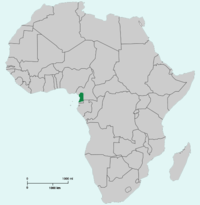- Goliath frog
-
Goliath frog 
Conservation status Scientific classification Kingdom: Animalia Phylum: Chordata Class: Amphibia Order: Anura Family: Ranidae Genus: Conraua Species: C. goliath Binomial name Conraua goliath
(Boulenger, 1906)
The goliath frog, Conraua goliath is the largest extant anuran on Earth. It can grow up to 33 cm (13 inches) in length from snout to vent, and weighs up to 3 kg (8 lb). This animal has a relatively small habitat range, mainly in Cameroon and Equatorial Guinea. Its numbers are dwindling due to habitat destruction, its collection for consumption as food and its collection for the pet trade.
Contents
Life history
The goliath frog can live up to 15 years in the wild. In captivity, they can live up to 21 years. While male Goliath frogs weigh up to 8 pounds, females can weigh up to 7. These frogs have acute hearing but no vocal sac, and additionally lack nuptial pads.
Habitat
The goliath frog is normally found in and near fast-flowing rivers with sandy bottoms in the West African countries of Cameroon and Equatorial Guinea. These rivers are usually clear and highly oxygenated. Their actual range spans from the last 200 km (120 mi) of the Sanaga basin in Cameroon to the north to the last 50 km (31 mi) of the Benito River basin in Equatorial Guinea to the south. The river systems in which these frogs live are often found in dense, extremely humid areas with relatively high temperatures.
Diet
The goliath frog, like most frogs, feed on worms, and insects, such as dragonflies and locusts. Bees and wasps could be prey, but since they have stingers they use as a weapon, the goliath frog rarely even catch one. Goliath Frogs also eat smaller frogs, large crabs, baby turtles, and young snakes. The goliath frog is also preyed on by snakes, Nile crocodiles and Nile monitors.
Reproduction
Like all amphibians the water is vital for their reproduction. The males will construct spawning and breeding areas alongside and within rivers by pushing rocks into semicircular patterns. Not much is known about the goliath frog's reproduction; however, some African scholars have started to do more research for medical reasons.
Relations with Humans
Goliath frogs were considered to be a source of food in some parts of west Africa. They were also highly exported to zoos and animal dealers to be sold as pets. Unfortunately, these frogs fail to thrive in captivity (and almost never reproduce there). Due to their classification as endangered, the Equatorial Guinean government has declared that no more than 300 goliaths may be exported out of the country per year. Some are captured and kept as pets.
References
- Amiet (2004). Conraua goliath. 2006. IUCN Red List of Threatened Species. IUCN 2006. www.iucnredlist.org. Retrieved on 11 May 2006. Database entry includes a range map and justification for why this species is endangered
- Sabater-Pi, J. (1985). Contribution to the biology of the Giant Frog (Conraua goliath, Boulenger). Amphibia-Reptilia, 6(2), 143-153.
External links
 Data related to Conraua goliath at Wikispecies
Data related to Conraua goliath at Wikispecies- Endangered Profile at AMNH
- Goliath frog at the Encyclopedia of Life
Media
- Photos of goliath frogs with people at Queensland Frog Society
- Conraua golaith at CalPhotos
 Media related to Conraua goliath at Wikimedia Commons
Media related to Conraua goliath at Wikimedia CommonsExtant anuran families by suborder Archaeobatrachia 
Mesobatrachia Neobatrachia Amphignathodontidae · Aromobatidae · Arthroleptidae · Brachycephalidae · Bufonidae · Centrolenidae · Craugastoridae · Dendrobatidae · Heleophrynidae · Hemiphractidae · Hemisotidae · Hylidae · Hyperoliidae · Leptodactylidae · Mantellidae · Microhylidae · Myobatrachidae · Petropedetidae · Pyxicephalidae · Ranidae · Rhacophoridae · Rhinodermatidae · Sooglossidae
This true frog article is a stub. You can help Wikipedia by expanding it.

